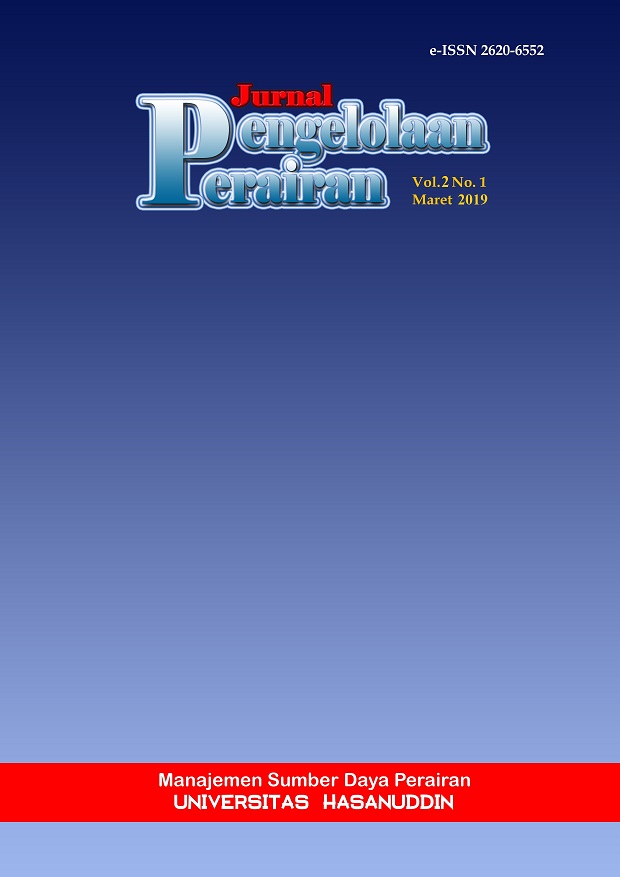Kajian pendahuluan pendugaan cepat densitas Spirulina sp dengan turbiditimeter untuk studi ekotoksikologi di era revolusi industri 4.0 (Preliminary study of quick assessment of Spirulina sp density using turbiditymeter for ecotoxicological studies in 4.0 industrial revolution era)
Abstract
Estimating the number of phytoplankton is something important in the field of aquatic science, including the field of aquatic ecotoxicology. Turbiditimeter is a device that can determine the level of turbidity of the water both caused by non-organic and organic matter, such as phytoplankton. Preliminary research has been conducted to estimate the number of phytoplankton, Spirulina, using turbiditymeter. The results showed that the correlation between the number of Spirulina which was directly estimated using the haemocytometer and the turbidity level detected by the turbiditimeter was statistically very strong and significant statistically (R = 0.9762 and S = 0.012). The linear equations of the correlation can be used to estimate the number of Spirulina with an error of 4.17-20.99% indirectly. The conclusion of this study is that turbiditimeter can be used to predict the number of phytoplankton indirectly.
Keywords : Quick assesment, ecotoxicology, Spirulina sp, turbidimetry, revolution, industry 4.0
References
Ferrando, N.S. , Benítez, H.H. , Gabellone, N.A. , Claps, M.C. & Altamirano, P.R. 2015. A quick and effective estimation of algal density by turbidimetry developed with Chlorella vulgaris cultures. Limnetica. 34(2):397–406.
Fowler, J. , Cohen, L. & Jarvis, P. 2013. Practical statistics for field biology. John Wiley & Sons.,.
Griffiths, M.J. , Garcin, C. , van Hille, R.P. & Harrison, S.T.L. 2011. Interference by pigment in the estimation of microalgal biomass concentration by optical density. Journal of microbiological methods. 85(2):119–123.
Hussain, I. , Ahamad, K. & Nath, P. 2016. Water turbidity sensing using a smartphone. RSC Advances. 6(27):22374–22382.
Hussain, I. , Das, M. , Ahamad, K.U. & Nath, P. 2017. Water salinity detection using a smartphone. Sensors and Actuators B: Chemical. 239:1042–1050.
LeGresley, M. & McDermott, G. 2010. Counting chamber methods for quantitative phytoplankton analysis—haemocytometer, Palmer-Maloney cell and Sedgewick-Rafter cell. UNESCO (IOC Manuals and Guides). :25–30.
Lewis, J. & Eads, R.E. 2009. Implementation guide for turbidity threshold sampling: principles, procedures, and analysis. US Department of Agriculture, Forest Service, Pacific Southwest Research Station.,.
Mylvaganaru, S. & Jakobsen, T. 1998. Turbidity sensor for underwater applications. In: IEEE Oceanic Engineering Society. OCEANS’98. Conference Proceedings (Cat. No. 98CH36259). vol. 1. IEEE.,. pp. 158–161.
Rodrigues, L. , Arenzon, A. , Raya-Rodriguez, M. & Fontoura, N. 2011. Algal density assessed by spectrophotometry: A calibration curve for the unicellular algae Pseudokirchneriella subcapitata. Journal of Environmental Chemistry and Ecotoxicology.
San Park, T. & Yoon, J.-Y. 2015. Smartphone Detection ofEscherichia coliFrom Field Water Samples on Paper Microfluidics. IEEE Sensors Journal. 15(3):1902–1907.
Schumann, R. , Häubner, N. , Klausch, S. & Karsten, U. 2005. Chlorophyll extraction methods for the quantification of green microalgae colonizing building facades. International Biodeterioration & Biodegradation. 55(3):213–222.
Travieso, L. , Benítez, F. , Sánchez, E. , Borja, R. , Martín, A. & Colmenarejo, M.F. 2006. Batch mixed culture of Chlorella vulgaris using settled and diluted piggery waste. Ecological Engineering. 28(2):158–165.


